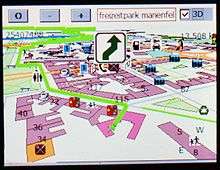Personal navigation assistant

A Personal Navigation Assistant (PNA) also known as Personal Navigation Device or Portable Navigation Device (PND) is a portable electronic product which combines a positioning capability (such as GPS) and navigation functions.
Some PNA devices are PDAs with limited features and can be unlocked.[1]
History
The earliest PNAs were hand-held GPS units (circa mid-1980s) which were capable of displaying the user's location on an electronic map. These units included simple navigation functions such as course-to-steer and course-made-good. This first generation of PNAs were used by the US military.
Market developments

According to the analyst firm Berg Insight, there were more than 150 million turn-by-turn navigation systems worldwide in mid-2009, including about 35 million factory installed and aftermarket in-dash navigation systems, over 90 million Personal Navigation Devices (PNDs) and an estimated 28 million navigation-enabled mobile handsets with GPS.[2]
The term PNA has come into widespread use with the growing popularity of automobile navigation systems. Original PNAs provided users with a map layer, real-time-traffic, and a routing engine with audio/visual cues for turn-by-turn guidance. The latest generation of PNA have sophisticated navigation functions such as parking assistance and personalization engines that enhance the user experience. To reduce total cost of ownership and time to market, most modern PNA devices such as those made by Garmin Ltd., Mio Technology Ltd. or TomTom International BV. are running an off-the-shelf embedded operating system such as Windows CE or Embedded Linux on commodity hardware with OEM versions of popular PDA Navigation software packages such as TomTom Navigator, I-GO 2006, Netropa IntelliNav iGuidance, or Destinator.
Other manufacturers such as Garmin and Magellan prefer to bundle their own software developed in-house. Because many of these devices use an embedded OS, many technically inclined users find it easy to modify PNAs to run third party software and use them for things other than navigation, such as a low-cost audio-video player or PDA replacement.
GPS equipped mobile phones have now eclipsed the sale of dedicated GPS units. Nokia, Samsung Electronics, Motorola and other handset makers were predicted to sell 162 million GPS equipped phones in 2007, dwarfing the 20 million units Garmin and TomTom have forecast they will sell combined, according to iSuppli, a leading market researcher in California. The inclusion of Google Maps Navigation in Android devices such as Motorola Droid and Nokia's announcement of free Ovi Maps has led to many people using their smartphones instead of having a separate PNA for trip navigation.